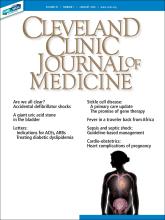Article Figures & Data
Tables
Hepatic Hepatic crisis: right upper quadrant pain, fever, jaundice, nausea, tender hepatomegaly, jaundice
Hepatic sequestration: abdominal pain, tender hepatomegaly, and acute anemia, but absence of cholestasis or transaminitis
Acute cholecystitisSplenic sequestration Sudden enlargement of spleen due to trapping of the red cell mass
Presents with left-sided abdominal pain, abdominal distention, pallor, acute anemia, hypovolemic shockStroke Focal seizures, hemiparesis, speech deficits; hemorrhagic stroke more common in adults Acute ocular conditions Hyphema, central retinal artery occlusion, orbital infarction, orbital compression syndrome Acute chest syndrome Fever, respiratory symptoms, chest pain, new infiltrate on chest radiography, hypoxia, acute anemia Acute anemia Decline of the hemoglobin level of 2 g/dL below the baseline value
Etiology includes red cell aplasia, delayed hemolytic transfusion reaction, acute bleeding (surgery), spleen sequestrationPriapism Painful sustained penile erection; urinary retention may occur Fever Repeated splenic infarctions from vaso-occlusion result in hyposplenism and functional asplenia, leading to increased susceptibility to infection from encapsulated organisms; sickle cell fever, defined as temperature > 38.3°C (101.5°F), should prompt rapid evaluation and initiation of antibiotics Pain Acute excruciating pain, most commonly in the extremities, chest, and back; onset may be gradual, duration may be hours to days; triggers include stress, exposure to cold, and infectious illness Multisystem organ failure Usually occurs during a vaso-occlusive crisis
Presents with fever, rapid fall in hematocrit and platelet count, and altered sensorium; respiratory, hepatic, and kidney failureData from American Society of Hematology. Management of Acute Complications of Sickle Cell Disease: A Pocket Guide for the Clinician. www.hematology.org/Clinicians/Guidelines-Quality/Quick-Ref/3466.aspx.
Nephropathy
Screen annually for albuminuria: spot urine test to estimate protein-to-creatinine ratio
If micro- or macroalbuminuria is present: 24-hour urine test
If protein excretion rate > 300 mg/24 hours, refer to a nephrologist
Consider angiotensin-converting enzyme inhibitor therapyPulmonary
Assess for respiratory problems
Pulmonary function testing
If findings suggest pulmonary hypertension, refer for cardiology evaluationHypertension
Screen; treat to ≤ 130/80 mm Hg aRetinopathy
Refer to an ophthalmologist for a dilated eye examinationb; rescreen in 1–2 years if normal
Refer to a retinal specialist for suspected retinopathyStroke
Screening limited to children
Blood transfusion: simple or exchange
HydroxyureacLeg ulcers
Inspect lower extremities for active and healed ulcers
Treat with debridement, wet-to-dry dressings, topical agents
Chronic recalcitrant deep leg ulcers: evaluate for osteomyelitis, consult wound care specialistReproductive counseling
Reproductive life plan
Refer partners for hemoglobinopathy status testing if status is unknown
Test women anticipating pregnancy for red blood cell alloantibodies
Discuss contraception choices with no restrictions for use in sickle cell disease: progestin-only contraceptives, barrier methods; reinforce the need for barrier methods for patients on hydroxyureaAvascular necrosis
Elicit from history and physical examination
Confirm with radiography and magnetic resonance imaging
Refer for physical therapy, orthopedic clinic↵a Systolic value based on updated American Society of Hematology guidelines on sickle cell disease management: https://ashpublications.org/bloodadvances/article/3/23/3867/429210/American-Society-of-Hematology-2019-guidelines-for.
↵b Sickle cell retinopathy is more common in the SC variant, but other genotypes carry a risk.
↵c While hydroxyurea has been shown to be comparable to transfusion therapy in the prevention of stroke, chronic transfusions have remained an efficient method of reducing the occurrence of secondary stroke.
From National Heart, Lung, and Blood Institute. Evidence-based management of sickle cell disease: Expert panel report, 2014. www.nhlbi.nih.gov/guidelines.
Vaccine Recommendation Haemophilus influenzae 1 dose, if not administered previously Meningococcal Meningococcal conjugate vaccine, then a booster every 5 years
Serogroup B meningococcal vaccine (2 doses, 2 months apart)Pneumococcal PCV 13 (if vaccine-naïve), then PSV 23 8 weeks later
Repeat PSV 23 5 years after initial doseHepatitis B 3-dose series: 0, 1, and 6 months Tetanus booster Every 10 years PCV 13 = pneumococcal conjugate vaccine; PSV 23 = pneumococcal polysaccharide vaccine
From the US Centers for Disease Control and Prevention. General best practice guidelines for immunizations: Altered immunocompetence. www.cdc.gov/vaccines/hcp/acip-recs/general-recs/immunocompetence.html.
Acute pain
Parenteral opioids
Nonsteroidal anti-inflammatory drugs (NSAIDs)
Frequent reevaluation for pain reliefChronic pain
NSAIDs, gabapentin, antidepressants (tricyclic antidepressants, serotonin-norepinephrine reuptake inhibitors)
Opioids: for pain not relieved by nonopioids and nonpharmacologic interventions
Refer to mental health professional as needed for depression, anxiety, dependence on pain medication
Nonpharmacologic: cognitive behavioral therapy, massage, meditation, relaxation techniques, transcutaneous electrical nerve stimulation
Collaborate with patient to develop a written individualized treatment plan
Educate patient to increase oral hydration and use stool softeners as neededFrom National Heart, Lung, and Blood Institute. Evidence-based management of sickle cell disease: Expert panel report, 2014. www.nhlbi.nih.gov/guidelines.






